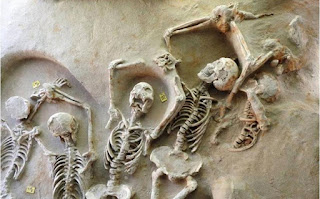SHACKLED GREEK SKELETONS MIGHT TELL THE STORY OF THE RISE OF ANCIENT ATHENS
Archaeologists studying ancient Greek shackled skeletons at
the cemetery of the ancient city of Palaion Faliron, in order to understand the rise of
the Athens city-state
The Faliron cemetery is of the largest of such sites that have been excavated in Greece as it contains more than 1.500 ancient Greek skeletons
and dates back to the 8th – 5th centuries BC.
Skeletons of people with their hands tied behind their backs,
in mass graves, are considered important in understanding the policies of
Athens at the time and how the city-state was established.
Excavations of the graveyard in Faliron started a century ago. But large-scale works were carried out
between 2012 – 2016 by the Department of Antiquities of the Hellenic Ministry of Culture led by archaeologist Stella
Chrysoudaki
Several ancient Greek skeletons were removed in blocks for future
micro-excavation Digitization of archaeological field records, photographs and
maps have also been done. However, Preservation
and analysis have been done by specialists in bioarchaeology and forensic anthropology.
The report says that the skeletons were buried in a variety
of ways. Most were buried in simple pit
graves but nearly one-third of the infants and children were buried in large
jars. About 5% of the remains found
are from cremations complete with funeral pyres and there are a few stone-lined
cyst graves. One person was buried in a
wooden boat like a coffin.
The skeletons have puzzled researchers as there were
instances of shackled deaths in the ancient world and could indicate punishment,
slavery or death sentence.
Examining and analyzing 1.500 skeletons by the
archaeobiologists and geoarchaeologists is a time-consuming and costly process and significant funding is needed.
The research team believes that the analysis of the
skeletons can give us a window into a critical time of ancient Greek history, just
before the rise of the city-state.
The four major objectives following conservation of
skeletons are:
1. To investigate the structure and other deviant burials,
including the individuals tossed into mass graves, and decide whether they are casualties
of the political upheaval that preceded the rise of the Athenian democracy.
2. To study the
burials of children, to learn more about infancy and childhood in the ancient world.
3. To learn more about people’s diet in the ancient city and
to find out if its inhabitants succumbed to diseases easily passed through
sailors and other travelers from distant lands.
4. To go beyond the analysis of elite individuals buried with elaborate grave goods by focusing on more simple burials, to shed light on the social classes of ancient Athens.
PLEASE DO BE VACCINATED AGAINST COVID – 19 SO THAT YOUR BELOVED FAMILIES, FRIENDS, THE WORLD, AND YOU REMAIN HEALTHY AND SAFE






No comments:
Post a Comment